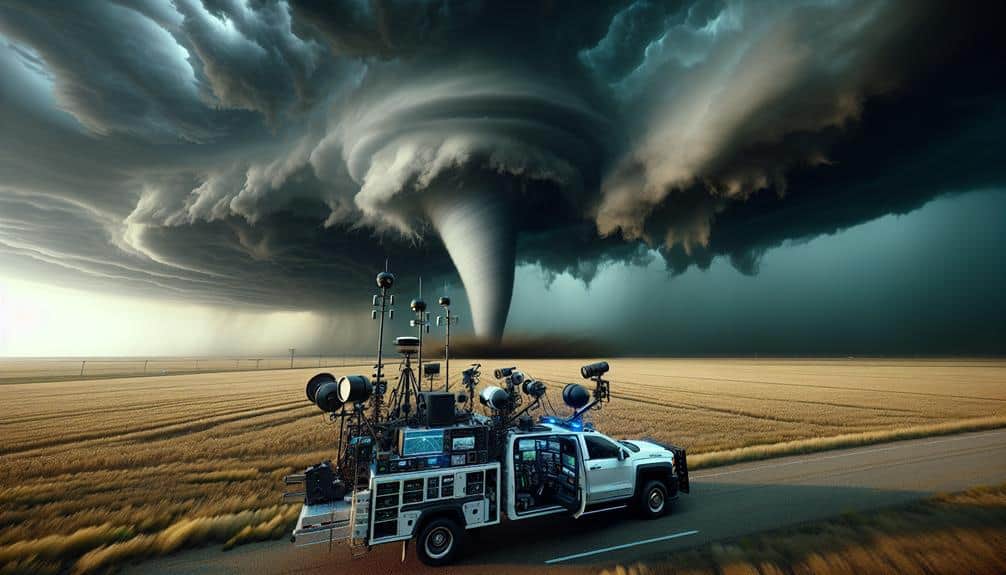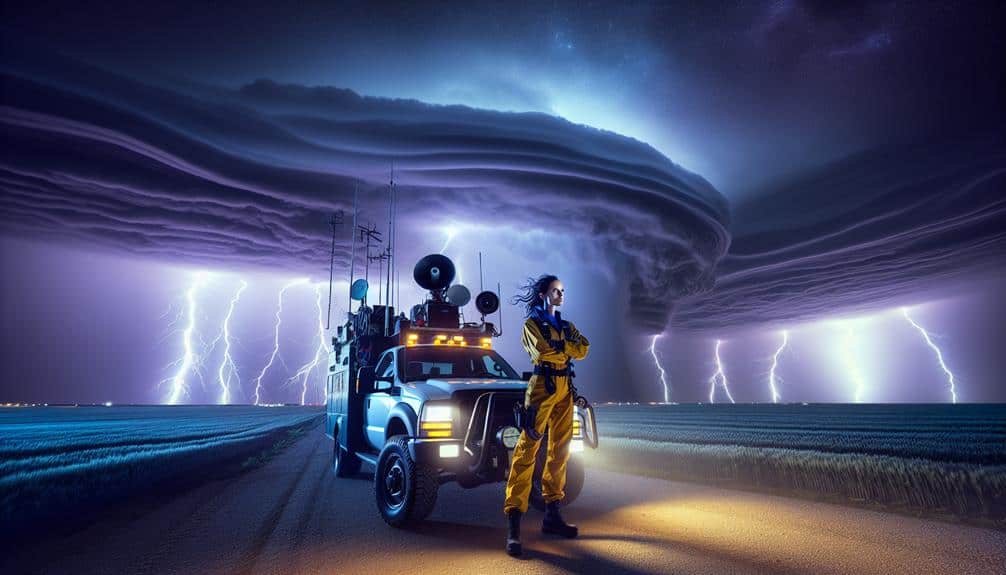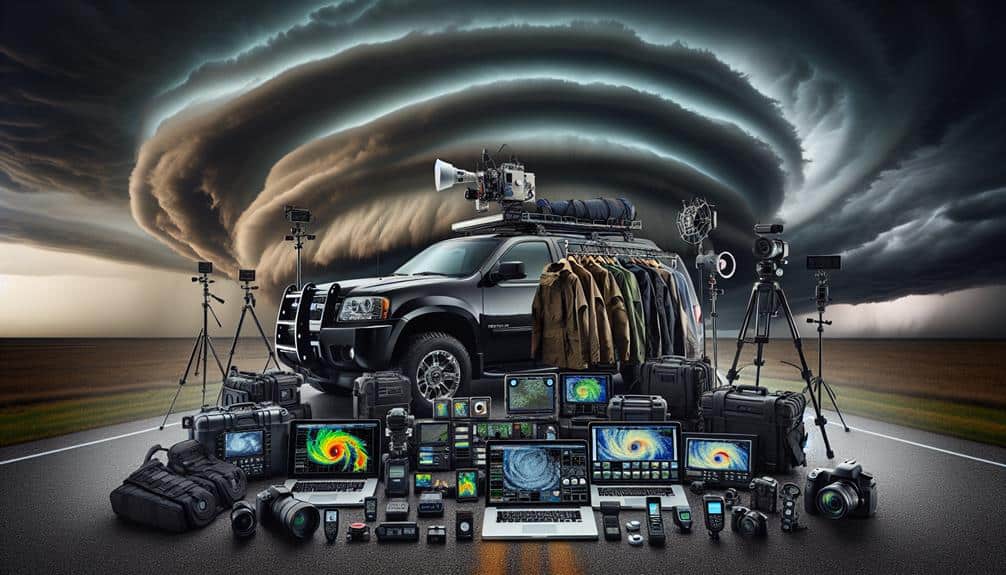When planning a storm chasing expedition, we must analyze historical weather data and understand synoptic scale patterns. Our vehicles need to be in top shape, and we should stock up on emergency supplies and high-quality tech gear. Safety is crucial, so we perform detailed risk assessments and establish clear communication plans. When planning routes, we use weather models, radar data, and GPS navigation, always knowing nearby shelters. Real-time updates and seamless team coordination guarantee we stay informed and act promptly. After the chase, we review meteorological data and video footage to refine our strategies and techniques for future chases. Discover how these elements intertwine to create a successful expedition.
Key Points
- Analyze historical weather data and current models to identify potential storm hotspots and seasonal trends.
- Ensure vehicle and equipment maintenance, focusing on high-quality tech gear and emergency supplies.
- Implement extensive safety measures, including risk assessments, communication plans, and designated meeting points.
- Utilize real-time updates and GPS tracking for dynamic route planning and navigation.
Research Weather Patterns
To effectively plan our storm chasing expedition, we must analyze historical weather data to identify patterns and trends. By diving into detailed data analysis, we can pinpoint the regions most frequently affected by severe weather events. Our meteorological knowledge allows us to interpret various data sets, including temperature, humidity, wind speed, and atmospheric pressure.
We begin with a thorough examination of past storm occurrences, utilizing databases such as the National Weather Service archives. By mapping these events, we observe recurring hotspots and typical seasonal variations. This analysis helps us predict the areas where storms are most likely to form, allowing us to plan our routes strategically.
Moreover, understanding the synoptic scale patterns, like jet streams and frontal systems, is essential. We use advanced meteorological models to simulate potential storm scenarios. These models, combined with real-time satellite imagery and radar data, refine our predictions. Our goal is to maximize our chances of encountering storms while minimizing risks.
Choosing the Right Equipment
Selecting the appropriate equipment is vital for the success and safety of our storm chasing expedition. To make sure we're well-prepared, we need to focus on meticulous gear selection and diligent equipment maintenance.
First, let's guarantee our vehicle is ready for the rugged conditions it will face. Proper vehicle preparation includes inspecting tires, brakes, and essential fluids. Emergency supplies are also important, ranging from first aid kits to emergency blankets and non-perishable food.
When it comes to our tech gear, high-quality cameras and weather instruments are non-negotiable. Reliable GPS and communication devices will keep us connected and on the right track. Each piece of equipment must be checked regularly to ensure best performance.
Here's a checklist to guide our preparations:
- Vehicle Preparation: Thorough inspection and maintenance of tires, brakes, and essential fluids.
- Emergency Supplies: Stock up on first aid kits, emergency blankets, and non-perishable food.
- High-Quality Tech Gear: Invest in durable cameras, weather instruments, GPS, and communication devices.
Safety Precautions
Ensuring our gear is ready, we must now focus on implementing extensive safety precautions to protect ourselves during the storm chasing expedition. First, conducting a detailed risk assessment allows us to identify potential hazards and mitigate them effectively. We need to evaluate weather forecasts, terrain conditions, and any specific challenges associated with the storm system we're chasing.
Emergency procedures are essential. We should establish a clear communication plan, ensuring all team members know how to reach one another and emergency services if necessary. Each vehicle should be equipped with a first aid kit, fire extinguisher, and emergency tools like a flashlight, multi-tool, and a portable weather radio. Additionally, it's crucial to designate a safe meeting point in case we get separated.
We must also consider our personal safety. Wearing appropriate clothing, such as weather-resistant outerwear and sturdy footwear, is necessary. Staying hydrated and well-nourished will keep our energy levels up and minds sharp. Regularly updating our location and status with a reliable contact outside the storm zone adds an extra layer of security.
When planning our route, we'll focus on selecting the best path that maximizes safety and storm observation opportunities.
Utilizing real-time weather updates is essential to adjust our course dynamically and avoid hazardous conditions.
Optimal Path Selection
To navigate storm chases effectively, we analyze real-time meteorological data and employ advanced mapping software to determine the safest and most efficient routes. By integrating storm analysis and tracking techniques, we can anticipate storm movements and adjust our paths dynamically. This approach not only maximizes our chances of capturing compelling footage but also guarantees our safety.
Selecting the best path involves several technical considerations:
- Storm Analysis: We scrutinize weather models and radar data to understand storm behavior, including speed, direction, and intensity.
- Tracking Techniques: Utilizing GPS and mobile apps, we stay updated on storm positions, allowing for real-time adjustments to our route.
- Route Flexibility: We plan multiple potential paths, ensuring we can quickly alter our course if the storm's trajectory changes unexpectedly.
Real-Time Weather Updates
How do we leverage real-time weather updates to refine our route planning and navigation during storm chases?
First, we integrate advanced storm tracking systems to monitor weather patterns continuously. These systems provide us with essential data, such as storm intensity, speed, and direction, allowing us to adjust our routes dynamically for best positioning.
Utilizing dedicated weather monitoring tools, we ensure that our team receives up-to-the-minute meteorological information. This real-time data empowers us to anticipate changes and make informed decisions swiftly. Effective communication protocols are essential; our team relies on secure, reliable channels to disseminate critical updates, optimizing everyone is aligned and aware of potential hazards.
Incorporating these updates into our navigation strategy enhances our safety and efficiency. We can avoid high-risk areas and optimize our pursuit routes, reducing the likelihood of encountering severe conditions unexpectedly. Additionally, we establish robust emergency response plans, leveraging real-time data to execute evacuations or shelter-in-place decisions promptly.
Communication Strategies

Effective communication strategies are vital for guaranteeing the safety and coordination of our storm chasing team during an expedition. Utilizing various communication channels provides us with the flexibility needed to adapt to rapidly changing conditions.
First, we must leverage social networking platforms for real-time updates and public awareness. This not only keeps followers informed but also helps us monitor any reports from other chasers in the vicinity.
Second, maintaining a list of emergency contacts is essential. We must make certain that all team members have access to these contacts, including local authorities and medical facilities.
Third, using reliable radio communication devices allows us to maintain contact in areas where cell coverage might be limited. Radios should be tested and set to agreed frequencies before departure.
Lastly, implementing a check-in system where team members report their status at regular intervals guarantees that everyone remains accounted for, even in the most chaotic situations.
- Social Media: Monitor and update for real-time information.
- Emergency Contacts: Accessible list for quick reference.
- Radio Communication: Ensure reliable, tested devices.
Team Coordination
In our storm chasing expeditions, effective team coordination is essential for safety and success.
We need to establish clear communication channels and implement precise role assignment strategies.
Clear Communication Channels
Establishing clear communication channels is crucial for seamless team coordination during a storm chasing expedition. We need to set up reliable methods for continuous updates and quick decision-making. We can't afford miscommunications in such high-stakes environments. Our success hinges on real-time information sharing and effective emergency protocols.
To begin with, we should implement structured team check-ins at regular intervals. These check-ins help us monitor everyone's status and adjust plans accordingly. Additionally, we must use robust communication tools that function even in areas with poor cellular coverage. Satellite phones or radios can be indispensable.
Here's a more detailed breakdown of our communication strategies:
- Regular Team Check-Ins: Scheduled updates ensure everyone is safe and on the same page.
- Emergency Protocols: Predefined steps for various contingencies keep us prepared for unexpected situations.
- Multi-Channel Communication: Utilize different communication methods to ensure redundancy (e.g., radios, mobile apps).
Role Assignment Strategies
To optimize our storm chasing efficiency, assigning specific roles to each team member guarantees that all tasks are covered and reduces overlap. By clearly defining responsibilities, we can streamline our operations and maintain our team dynamics remain cohesive.
Effective leadership strategies play a pivotal role in this process, as a well-organized team can respond swiftly to changing weather conditions.
Task delegation is crucial for maintaining focus and expertise in critical areas. One member might be responsible for navigation, ensuring we stay on prime routes, while another focuses on real-time weather data analysis. A designated photographer can capture high-quality images, and a safety officer ensures adherence to safety protocols. These roles should be assigned based on individual strengths and experience, fostering a sense of accountability.
Accountability measures are also essential. Each team member must understand their tasks and be prepared to execute them precisely. Regular briefings can help reinforce responsibilities and address any issues promptly.
Post-Chase Analysis

We thoroughly review all collected data to identify patterns and anomalies observed during the storm chase. Our post-chase analysis begins by syncing all recorded footage, sensor readings, and GPS logs. This step ensures that our data analysis remains accurate and all-encompassing.
We then focus on storm tracking to correlate observed storm behaviors with predicted models. Through this, we can refine our future tracking methodologies.
- Meteorological Data: We analyze temperature, humidity, wind speed, and atmospheric pressure records to detect any significant deviations.
- Video Footage: Reviewing visual evidence helps us validate sensor readings and identify visual markers of storm intensity.
- GPS Logs: Mapping our exact routes provides insights into storm movement and our response times.
Frequently Asked Questions
What Are the Best Times of Year for Storm Chasing?
We've found the best locations for storm chasing during peak season are in Tornado Alley, particularly April to June. Conversely, the worst times are winter months. However, off-season opportunities exist in the Southern Plains during fall.
How Can I Find Experienced Storm Chasers to Mentor Me?
To find experienced storm chasers to mentor us, we should attend storm chaser meetups and participate actively in online forums. These platforms connect us with seasoned professionals, offering invaluable insights and fostering a sense of community and freedom.
What Kind of Insurance Should I Have for Storm Chasing?
We should guarantee weather coverage and emergency assistance to stay safe. Additionally, equipment protection safeguards our gear's longevity, while liability coverage shields us from legal issues. These measures grant us the freedom to chase storms responsibly and confidently.
How Do I Balance Storm Chasing With My Regular Job or Responsibilities?
Balancing storm chasing with our regular jobs requires strategic time management and prioritization. We must guarantee a work-life balance through meticulous scheduling, allowing for both our professional responsibilities and the freedom of chasing storms.
What Are Some Common Mistakes to Avoid as a Beginner Storm Chaser?
With 80% of storm chasers encountering close calls, let's prioritize safety precautions and a thorough equipment checklist. We can't afford to overlook these essentials, as our passion for freedom shouldn't compromise our well-being.


